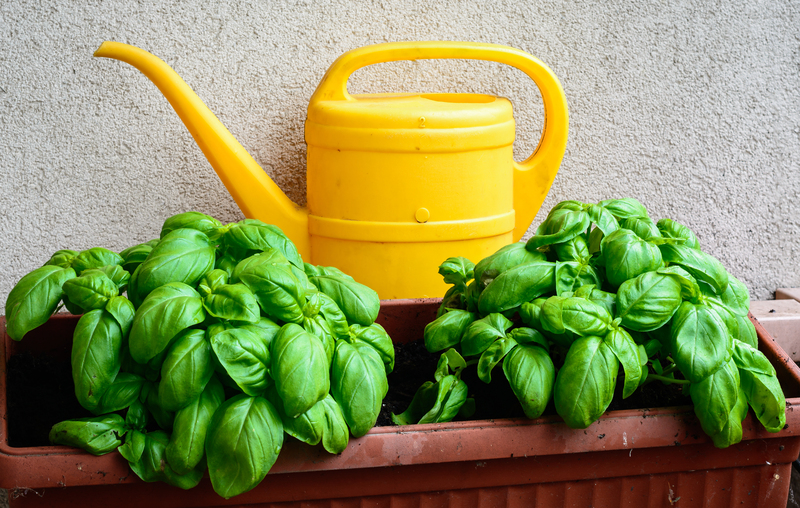Bring Your Plants Through Storms Safe and Sound
Posted on 14/06/2025
Bring Your Plants Through Storms Safe and Sound: The Ultimate Guide
Whether you're a seasoned gardener or a plant-loving beginner, fierce weather can create anxiety about your precious greenery. Stormy weather--from torrential rain and violent winds to unexpected hail--poses serious risks for your home garden and indoor plants. But, you don't need to feel powerless. This comprehensive guide will show you how to bring your plants through storms safe and sound, using expert-approved strategies for every scenario.

Understanding the Threat: How Storms Affect Plants
Storms are unpredictable forces of nature that bring various threats to your garden and houseplants. Recognizing these dangers is your first step to building plant resilience.
Common Storm-Related Hazards
- High winds: Can break branches, uproot young trees, and topple containers
- Heavy rain: Leads to soil erosion, waterlogging, and root rot
- Hail: Damages leaves, flowers, and fruits, sometimes irreparably
- Lightning: Rare, but can cause burns and fire hazards
- Flooding: Drowns roots, washes away nutrients, and spreads disease
Vulnerable Plant Types
Typically, the most threatened plants during storms include:
- Young saplings (with shallow roots)
- Climbers and vines (prone to wind damage)
- Potted plants (topple easily)
- Delicate herbs or annuals (can't withstand lashing rain)
Pre-Storm Preparation: Setting Your Plants Up for Survival
1. Choose Storm-Resistant Plants (Where Possible)
Consider planting native species or those renowned for strong roots and flexible stems. Plants adapted to your region's climate often withstand severe weather better and recover faster.
2. Strategic Garden Design
A well-designed garden acts as its own storm shield. Consider these tips:
- Windbreaks: Plant shrubs or small trees to shield vulnerable areas
- Sturdy trellises: Support climbing plants with strong, deep-set structures
- Raised beds: Reduce flood risks and promote drainage
- Mulching: A thick mulch protects roots, reduces soil erosion, and slows heavy downpours
3. Inspect Your Plants Regularly
Frequent inspection--and early intervention--are crucial in storm season. Look for weak branches, leaning trees, or pots without proper drainage, so you can act before disaster strikes.
4. Secure Containers and Hanging Baskets
Before a storm hits, gather all portable plants and move them to a sheltered location: along a fence, under a patio, or indoors if possible. Tie down or weight larger containers, and make sure hanging baskets are firmly attached or temporarily removed.
5. Pruning and Cleanup
Remove dead branches, leaves, and flowers regularly, especially before a forecasted storm. Proper pruning reduces the risk of breakage and improves airflow, making it harder for strong wind to damage your plants.
6. Healthy Roots, Healthy Plants
Deep-rooted plants withstand wind far better than those with shallow roots. Water early and infrequently to encourage plants to "reach" deeper rather than spreading out. Avoid fertilizing just before a storm, as this encourages soft new growth, which is easily damaged.
7. Emergency Support
- Stakes and ties: Provide extra support for young trees and tall perennials.
- Row covers or garden fabric: Shield delicate plants from hail and heavy rain.
- Temporary shelters: For prized or sensitive specimens, create makeshift covers from plastic bins, buckets, or even upturned pots.
During the Storm: Quick Actions to Protect Your Plants
1. Bring Vulnerable Plants Indoors
If you have time, bring containers and potted plants inside--especially if wind gusts are extreme or hail is predicted. Use your garage, porch, or even a shaded bathroom. Group plants together to create a humid microenvironment.
2. Cover Outdoor Plants
Use frost cloths, tarps, old bed sheets, or specially designed plant covers to protect the most delicate plants from harsh conditions. Secure covers at the base with heavy objects or pegs, ensuring there's room for airflow.
3. Protect Garden Infrastructure
- Secure trellises, cages, and stakes so they don't become projectiles or damage your plants
- Lay tall pots on their sides, out of the wind's direct path
- Drain saucers and trays to prevent standing water
4. Avoid Fertilizing or Pruning Right Before the Storm
Fertilizing can encourage soft growth, while last-minute pruning leaves plants at risk of infections and water loss. Both make your plants more vulnerable, not less.
After the Storm: Rescue and Recovery
1. Assess the Damage Safely
Once the weather clears, inspect your garden thoroughly--but do so with caution. Watch for hazards such as downed electrical lines, slippery surfaces, or sharpened broken branches.
2. First-Aid for Plants
- Remove broken branches: Cut cleanly back to a healthy node using sterilized pruners
- Upright toppled plants: Replant and stake young trees or perennials if roots are exposed
- Clear mud and debris: Gently hose off leaves to prevent disease but wait for the sun to return so foliage can dry
- Monitor for root rot: Watch for wilting or yellowing; act fast to improve drainage if soil stays wet
3. Be Patient
Plants are more resilient than we think! Give them time to recover before you try to replace or move them. Keep an eye out for pests--storm damage provides an opening for opportunistic bugs and diseases.
4. Soil Rehabilitation
Heavy rainfall and flooding can strip your soil of nutrients. After the ground has dried out a bit, top-dress with compost or slow-release organic fertilizer. Aerate compacted areas gently--don't dig too soon, as this can damage tender roots.
Special Tips for Indoor & Houseplants
1. Move Plants Away from Windows
Strong winds can send branches, debris, or hail through glass. Move houseplants at least a few feet away from windows and skylights, especially if storms are severe.
2. Adjust Light & Watering
Stormy weather often means less sunlight and higher humidity. Cut back a bit on watering, and use grow lights or reposition plants if cloudy conditions persist for several days.
3. Power Outages: Managing Indoor Plant Stress
- Prolonged darkness? Move light-needy houseplants outdoors (in the shade) for a few hours once the storm has passed
- Maintain airflow to prevent mold by opening doors when safe
- If you lose heat in a winter storm, cluster plants together and insulate with towels to retain warmth
Long-Term Storm-Proofing for the Future
1. Build Wind-Resistant Defenses
Add hedges, fences, and cluster planting to diffuse wind power throughout your garden. Plant taller trees upwind as natural shields, and use varied plant heights and structures for maximum protection.
2. Invest in Resilient Infrastructure
- Choose heavy, non-tippable pots for container gardens
- Install permanent garden stakes and trellises
- Use permeable paving stones and rain gardens to direct floodwater
3. Keep an Emergency Kit Ready
Assemble a storm prep kit containing:
- Burlap or plant covers
- Sturdy stakes and ties
- Extra mulch or straw
- Garden gloves, disinfectant for tools, and a first-aid kit (for you and your plants!)
4. Stay Informed
Monitor local weather and sign up for garden advisory alerts. Knowing when and what type of storm is coming gives you a critical advantage to take action early.

Don't Let Storms Deter Your Green Thumb
Gardening is an act of hope and resilience. By applying these strategies to bring your plants through storms safe and sound, your landscape will not only survive but thrive--no matter what the weather brings! With the right preparation, quick response, and patient recovery, you can outsmart Mother Nature's wildest moods and continue enjoying a lush, living paradise.
Have you weathered a storm with your plants? Share your tips and stories in the comments below!
FAQs: Weathering Storms with Plants
-
Q: Which plants are most likely to survive storms?
A: Native, deep-rooted, and flexible-stemmed plants resist damage best. Ask your local nursery about storm-hardy varieties. -
Q: What's the fastest way to protect plants if a storm is already here?
A: Move containers indoors, lay tall pots on their sides, and throw lightweight covers over delicate beds. -
Q: How can I tell if my plants are waterlogged after a storm?
A: Watch for wilting, yellow leaves, and "mushy" roots. Improve drainage immediately and remove excess water from trays.
Storms will come and go, but with the right care, your garden can weather them all. Protect your plants, and they'll reward you with beauty for seasons to come!

